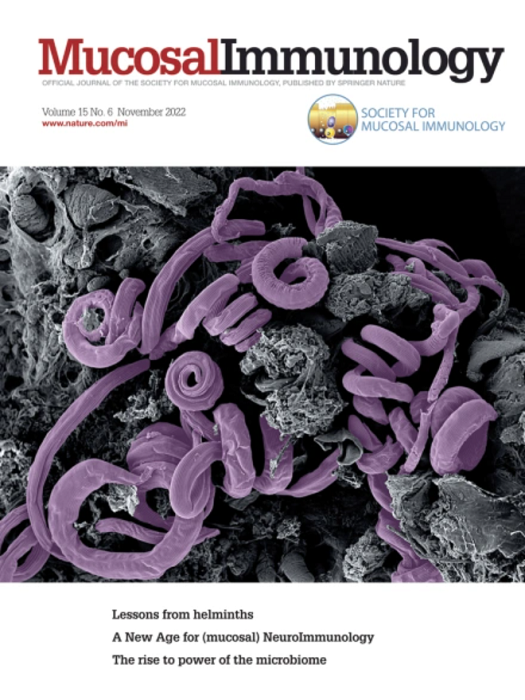空间分离的上皮相关中性粒细胞和固有层中性粒细胞在炎症的结肠粘膜中表现出不同的功能特征。
IF 7.6
2区 医学
Q1 IMMUNOLOGY
引用次数: 0
摘要
炎症性肠病(IBD)以结肠组织大量中性粒细胞(PMN)浸润为特征,其中PMN占据空间上不同的壁龛,包括固有层粘膜(lpn)和隐窝上皮(上皮相关中性粒细胞或ean)。空间PMN定位目前被用作临床疾病评分参数,EAN的存在与疾病严重程度、预后和治疗反应降低相关。令人惊讶的是,尽管PMN异质性及其在IBD中的临床相关性现已得到充分认识,但定位驱动的PMN专业化尚未得到研究。我们发现,在疾病活动期初始PMN流入后,UC缓解患者和小鼠结肠炎的ean几乎完全消失,而lpn在整个缓解期持续存在,这意味着ean可能是疾病的驱动因素。转录程序的局部分析(通过小鼠和人类单细胞RNA测序,加上人类空间RNA转录组学)和功能表型,包括小鼠炎症结肠中lpn与ean的实时活体成像,显示lpn和ean具有不同的功能身份。LPN程序允许增强运动性和病原体摄取,而ean过度表现为过度激活/促凋亡状态,ROS升高和炎症性TNFα产生。因此,我们证明结肠lpn和ean具有不同的功能特性,ean表现出激活状态和明显的细胞毒性,这可能积极促进组织损伤。我们的研究结果进一步确定ean是改善UC粘膜愈合和维持临床缓解的潜在治疗靶点。本文章由计算机程序翻译,如有差异,请以英文原文为准。

Spatially separated epithelium-associated and lamina propria neutrophils present distinct functional identities in the inflamed colon mucosa
Inflammatory Bowel Disease (IBD) features en masse neutrophil (PMN) infiltration of the colon tissue, where PMNs occupy spatially distinct niches, including the lamina propria mucosa (LPNs) and the crypt epithelium (epithelium-associated neutrophils or EANs). Spatial PMN localization is currently used as a clinical disease scoring parameter, and EAN presence has been correlated with disease severity prognosis and reduced response to therapy. Surprisingly, although PMN heterogeneity and their clinical relevance in IBD is now well-recognized, localization-driven PMN specialization has not been investigated. We found that following initial PMN influx during the active disease phase, EANs were near-completely resolved in both UC remission patients and in murine colitis, whereas LPNs persisted throughout the resolution phase, implicating EANs as likely drivers of disease. Local profiling of transcriptional programs (by murine and human single-cell RNA sequencing, coupled with human spatial RNA transcriptomics) and functional phenotypes, including real-time intravital imaging of murine LPNs versus EANs in inflamed colon revealed LPNs and EANs to have distinct functional identities. LPN programs allowed for heightened motility and pathogen uptake, whereas EANs were overrepresented by hyperactivated/pro-apoptotic states with elevated ROS and inflammatory TNFα production. Thus, we demonstrate that colon LPNs and EANs have distinct functional identities, with EANs exhibiting activated states and apparent cytotoxicity, which may actively contribute to tissue damage. Our findings further identify EANs as potential therapeutic targets for improving mucosal healing and sustaining clinical remission in UC.
求助全文
通过发布文献求助,成功后即可免费获取论文全文。
去求助
来源期刊

Mucosal Immunology
医学-免疫学
CiteScore
16.60
自引率
3.80%
发文量
100
审稿时长
12 days
期刊介绍:
Mucosal Immunology, the official publication of the Society of Mucosal Immunology (SMI), serves as a forum for both basic and clinical scientists to discuss immunity and inflammation involving mucosal tissues. It covers gastrointestinal, pulmonary, nasopharyngeal, oral, ocular, and genitourinary immunology through original research articles, scholarly reviews, commentaries, editorials, and letters. The journal gives equal consideration to basic, translational, and clinical studies and also serves as a primary communication channel for the SMI governing board and its members, featuring society news, meeting announcements, policy discussions, and job/training opportunities advertisements.
 求助内容:
求助内容: 应助结果提醒方式:
应助结果提醒方式:


